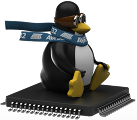OpenEmbedded / Angstrom Demo
Requirements
- SAM board
- power supply
- Serial, USB & Ethernet cables
- USB hub
- USB keyboard & mouse
- USB key
- SD card
- headphones
- Computer to control the demo via serial line or SSH access
Setup
Once the Linux kernel and root filesystem loaded, you can access the Linux console through the serial line plugged on DBGU port.Use the
root login account without password.
Network configuration
To let your target use the Network you have to configure it.- using a DHCP server
- using a static TCP/IP configuration
ifconfig command, setup a free IP address suitable for your network :
root@at91sam9263ek:/$ ifconfig eth0 10.159.245.170 eth0: link down eth0: link up, 100Mbps, full-duplex, lpa 0x45E1
SSH access
The ssh client cannot connect to the dropbear SSH target server using theroot account. An user account with password have to be created with the adduser command :
root@at91sam9263ek:/$ adduser foo_user Changing password for foo_user Enter the new password (minimum of 5, maximum of 8 characters) Please use a combination of upper and lower case letters and numbers. Enter new password: Re-enter new password: Password changed.
Run applications
General advices:- run one application at a time : it is an embedded system with not so much memory !
- each time a text field has to be filled, the virtual keyboard shows up: do not be surprised. This is a feature for PDA class devices. It can of course be disabled.
- appart from using the USB keyboard, you can enter text with virtual keyboards (two models) or with the
rosettathe handwriting recognition program : it is fun to test entering text with both !
Calendar
Beware, the action of clicking on theday view sets a calendar event: the window spawn slowly : do not double-click
Sketch Book
Very good to test touchscreen behavior.Games
- Tetris : use the USB keyboard
- Go : a two players game
Calculator
IRC client
Can be fun if connected to InternetText Editor
Can be used to show therosetta the handwriting recognition program. Beware: the rosetta handwriting have to be learned : do not expect very good results the first time.
Terminal
Low interest but can be a pleasure for geeks
File manager
Can be used to show the media hot plug capacity : connect the USB key and/or SD card now to show the "automount" capacity :- go in the
/mediadirectory - try to open
/media/sdaor/media/mmcblk0p1: no media in the slot : no data - plug the media
- wait for a little while
- use the refresh button
- the media data appear
Image Gallery
Go have a loot at images that you media contains using the open button : USB key (/dev/sda or /media/sda1 or SD card /media/mmcblk0p1).
Beware that image scaling is very CPU consuming : scale images on your host before viewing them on the target. Remember, that is what is done on famous portable media players (with a fronted application to load content in them) !
=> images format : 320x240
Note: you can make a sideshow.
Adjust audio output
Video player : mplayer
Setup:- setup
DISPLAYenvironment variable :
export DISPLAY=:0
- put the screen into landscape mode : two commands available :
-
screen rotatorapplet in the utilities menu -
xrandr -o left - adjust audio output following advices above
-
mplayer -vo sdl -sws 0 -hardframedrop -fs <your_movie_file>=> you can rotate back the screen in portrait mode using this command :
xrandr -o normal
Install new applications
Check the dedicated page : OpenEmbeddedAngstromUse#With_pre_built_packets_in_handsr8 - 10 May 2011 - 16:21:52 - NicolasFerre
Linux4SAM
Open source solutions ApplicationsBoards
- SAM9X75 Curiosity
- SAMA5D29 Curiosity
- SAM9X60 Curiosity
- SAMA7G5-EK
- SAMA5D2-ICP
- SAMA5D27 WLSOM1 EK
- SAM9X60-EK
- SAMA5D27 SOM1 EK
- SAMA5D2 PTC EK
- SAMA5D2 Xplained
- SAMA5D3 Xplained
- SAMA5D4 Xplained
- Older boards
FAQ
Useful links
- Microchip Microprocessors forums
- AT91 Community (archive)
- Microchip
- Linux4Microchip on GitHub
- Linux4SAM on GitHub
NAVIGATION
Copyright © by the contributing authors. All material on this collaboration platform is the property of the contributing authors.
Linux® is the registered trademark of Linus Torvalds in the U.S. and other countries.
Microchip® and others, are registered trademarks or trademarks of Microchip Technology Inc. and its subsidiaries. ![]()
Arm® and others are registered trademarks or trademarks of Arm Limited (or its affiliates). Other terms and product names may be trademarks of others.
Ideas, requests, contributions ? Connect to LinksToCommunities page.
